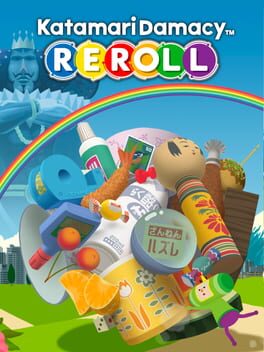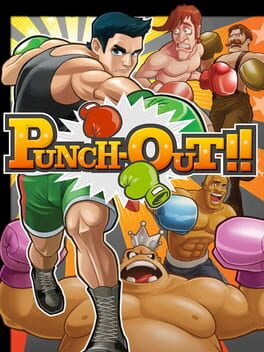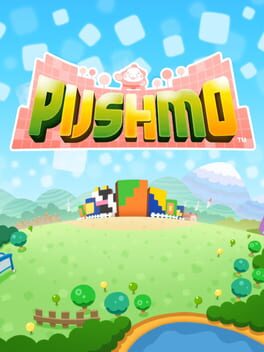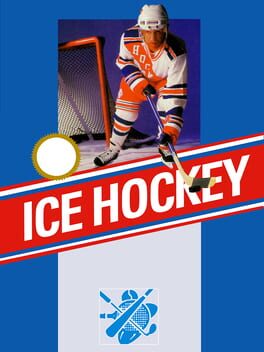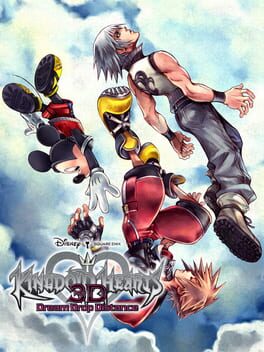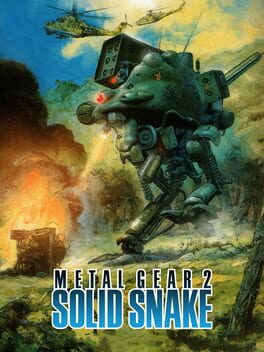AnthonyP
7 reviews liked by AnthonyP
To me, Katamari Damacy is the margherita pizza of video games. It's one of the simplest yet most innately fulfilling concepts in the medium: roll up things with your ball to become big to roll up more things. While this description is accurate however, it doesn't do justice towards the game's underlying complexity. Committal tank controls combined with the seemingly strewn about yet carefully placed objects of varying sizes means that Katamari forces players to consider both the micro and macro design which the game effortlessly excels at. The player must weave in and out of clusters of increasingly large objects, building up their sphere while also mapping out the optimal paths (snagging relevant objects while factoring in how their shapes, once collected, will alter the roll) and keeping in mind how larger objects must be avoided at first and later consumed in the growing mass as the world appears to shrinks around you. For this reason, I think it's not just a simple power fantasy, and instead more closely resembles pure obstacle escalation. Katamari Damacy really drills in the sense of player progression from how the world unfolds from sense of scale (which is why it gets away with only three distinct stages) and even seemingly inverts its own concepts with side stages that force you to avoid smaller themed objects just to get your katamari to the perfect size for the ultimate outcome: the reward is made that much more gratifying with just a bit of restraint.
This all works seamlessly because Katamari is the king of player feedback. It can certainly feel frustrating at first, getting tossed around like fireworks by these moving objects that dwarf you, but the game knows exactly how to communicate your inherent progress. As your ball exponentially swells, these moving objects go from sending you flying, to lacking any significant impact upon contact, to eventually spotting the player and running away from the growing catastrophe. There's nothing more viscerally satisfying than coming back to mobile obstacles that were pushing you around and flattening them, hearing their cry as they too become stuck in the jumbled mess of rolling flotsam while the King of the Cosmos quips in the background. Simply put, the concept never outstays its welcome.
Going back to the opening metaphor, it requires much finesse to make all these different concepts sing together with little friction in a video game, this fusion of audio-visual presentation and player input. That said, to successfully disguise its intricate design and depth beneath its far-reaching artistic vision and simple yet realized gameplay mechanics takes a master's touch. Katamari Damacy does not try to explain why it works or how it succeeds, because it simply is, and it just does. Perhaps I've moved onto greater and grander things since that have built off of this, but I have to admit that sometimes, you just can't beat the basics in life. It's always worth going back for a slice or two every now and then, just to remind yourself that this is why video games exist in the first place: because underneath all this talk of focus and cohesion, video games are just goddamn fun.
Also, it's fantastic hangover food for you and your buddies after a long night, when they come calling you for content and suddenly it's 3 AM in a packed Discord call where everyone is wailing "YOU'REEEEE LONNEEELLLY ROLLING STARRRR" as this growing, screaming ball of flailing limbs bounces helplessly about for yet another awry creation. Let the good times roll.
This all works seamlessly because Katamari is the king of player feedback. It can certainly feel frustrating at first, getting tossed around like fireworks by these moving objects that dwarf you, but the game knows exactly how to communicate your inherent progress. As your ball exponentially swells, these moving objects go from sending you flying, to lacking any significant impact upon contact, to eventually spotting the player and running away from the growing catastrophe. There's nothing more viscerally satisfying than coming back to mobile obstacles that were pushing you around and flattening them, hearing their cry as they too become stuck in the jumbled mess of rolling flotsam while the King of the Cosmos quips in the background. Simply put, the concept never outstays its welcome.
Going back to the opening metaphor, it requires much finesse to make all these different concepts sing together with little friction in a video game, this fusion of audio-visual presentation and player input. That said, to successfully disguise its intricate design and depth beneath its far-reaching artistic vision and simple yet realized gameplay mechanics takes a master's touch. Katamari Damacy does not try to explain why it works or how it succeeds, because it simply is, and it just does. Perhaps I've moved onto greater and grander things since that have built off of this, but I have to admit that sometimes, you just can't beat the basics in life. It's always worth going back for a slice or two every now and then, just to remind yourself that this is why video games exist in the first place: because underneath all this talk of focus and cohesion, video games are just goddamn fun.
Also, it's fantastic hangover food for you and your buddies after a long night, when they come calling you for content and suddenly it's 3 AM in a packed Discord call where everyone is wailing "YOU'REEEEE LONNEEELLLY ROLLING STARRRR" as this growing, screaming ball of flailing limbs bounces helplessly about for yet another awry creation. Let the good times roll.
Punch-Out!!
2009
Mr. Sandman came out of the screen and ripped my thumbs off.
Jokes aside, this was a great time and you can tell that Next Level Games was passionate about the franchise. There is a lot of challenge here while still being easy to pick up and play for a few minutes!
No but really, Mr. Sandman was a real test of my patience, reaction time, and button-mashing stamina.
Jokes aside, this was a great time and you can tell that Next Level Games was passionate about the franchise. There is a lot of challenge here while still being easy to pick up and play for a few minutes!
No but really, Mr. Sandman was a real test of my patience, reaction time, and button-mashing stamina.
Pushmo
2011
So, that's it for the 3DS eShop, another graveyard of cherished exclusives and flash-in-the-pan experiments which Nintendo will unceremoniously move on from. Not us who lived through it, of course (and we're still able to redownload our libraries, which means even the corp's data centers are holding on). The Big N counts on its newer audiences never fully realizing what they're deprived of, but that's where retrospectives and critical writings both on Backloggd and elsewhere can do some good. Countless years of platform history, and the less lionized parts of developers' histories, would otherwise get lost in the shuffle of countless new systems and software libraries. Pushmo is a perfect example of something once notable but now more at risk of broad indifference or revisionism than ever, aided by its publisher's aversion to curating its legacy in a post-Iwata world. And that's a damn shame because Intelligent Systems' puzzle-platformer played an important part in buoying the 3DS' launch year, with an addictive game loop and plenty of replayability even now thanks to level editing and QR codes.
Pushmo strikes me as a peek into an alternate timeline where the Fire Emblem franchise simply didn't recover from its downturn. Int-Sys likely saw the writing on the wall, given all their staff interviews expressing a real fear of, and resignation to, Awakening being the last true entry in that series. They needed what Jupiter Corp. has with its endless Picross series, a forever repeatable puzzle concept appealing to just about everyone in just about any context, keeping their paychecks secure despite the seemingly inevitable death of their prestige IP. So we got this, a modest but meaty killer app which the eShop sorely needed in lieu of upcoming blockbusters. All seemed going to plan, with critical acclaim and constant word of mouth giving Crashmo and Pushmo World on Wii U the greenlight. But then a funny thing happened: that 3DS Fire Emblem game Int-Sys doubted could resurrect that series? It outperformed the previous FE releases combined, setting a new mandate for the company. The Puzzlemo segue suddenly looked a lot more out of place (alarmist, even) than anticipated.
So today we have seemingly no end of Fire Emblem, Paper Mario, and WarioWare goodness from this long-time Nintendo partner, but nothing like their mid-2010s experiments with these cute block-em-ups, let alone anything as out there as Code Name S.T.E.A.M.. It sucks because, unless you're willing to sail the high seas, this part of Int-Sys' back catalog might as well not exist. What precisely does a spate of throwback logic and jumping exercises, set to orchestral chiptunes and a family-friendly exterior, offer to anyone better acquainted with Three Houses or The Origami King? I'd argue that Pushmo represents the developer's talents in their most pure form, though. It's that very lack of frills, thrills, bombast, and grandiosity which this small series proved it could do without, squaring up to the tentpole stuff with such ease and elegance. One might argue there's not much new here beyond the 3D gimmick, but I digress.
The player's goals of rescuing little sumo wrestlers from sabotaged contraptions in a park is simple enough for Int-Sys to launch players through tutorials before they get bored. Yet it's still flexible by the time this game reaches its proper tier of challenge—those later rounds where one must carefully view the puzzle, backtrack from mistakes, and think multiple steps ahead of danger. I definitely wish all of these Puzzlemo installments offered experienced users the ability to skip earlier worlds via some kind of test/exam mode, just to save me some time on replays, but I don't mind the early stages. They stimulate my small pathetic monkey brain every time I hear that wonderful "clear!" jingle, after all. My main issue with Pushmo comes from the lack of added mechanics towards the end, which lets repetition and a feeling of sameness creep in. Solving pixel art murals is fun much like in Jupiter's nonogram paradigm, but not quite enough.
Even with its limited scope and novelty, I find it super rewarding to revisit Pushmo on Citra today. Quite a few WarioWare staffers led development on this and the rest of the series, hence its ease in activating that "one more turn!" sensation. Each world's paced and sequenced appropriately, feeling like a gentle upward climb vs. the difficulty cliffside that Crashmo provides. This linear mastery of pushing and pulling, navigating tight jumps, cutting off your escape to proceed higher…it all adds up once you reach the bonus worlds, full of homage to Nintendo icons and classic puzzling. Another important piece of the progression is unlocking new options in the level editor, a very relevant feature given how well the game teaches you to recognize and reproduce smart designs. I never got the full experience of building puzzles and sharing them with friends via QRs, sadly, but I can't imagine the lack of said feature here and in the sequels. That same joy that kids made and shared with Lode Runner and Excitebike in the '80s lives on in forms like this, all true to that Family Computer and Game Boy ethos of uncomplicated play.
Much of the game's appeal to me now comes from the aesthetic it promotes. Now, I'm typically not a fella with a penchant for twee or adulterated audiovisuals in my media diet. Anything that feels desperately cuddly, or unwilling to settle on a distinct audience, just seems cowardly to me most of the time. Pushmo avoids this by pairing its Saturday-morning-edutainment look with unassuming but involving brain-teasers, the kind that even adults can sink effort into. This visual style accomplishes a couple things: (a) keeping all elements distinct and readable even when complex, and (b) making me feel like a dumb lil' kindergartner again when I eventually mess up. Some other Nintendo releases from this period went too far in acting cute and patronizing to players—think Skyward Sword or Freakyforms—which is why I think Int-Sys' success here is commendable. Shout-outs to those lovely melodies, too! They're an effortless mind-meld of Famicom-era bleepity bloops and lush orchestration that complement each other maybe too well.
Questions like "where did Puzzlemo go?" bug me for lack of an easy answer. Maybe it's simply the sequels being either too hard for most (Crashmo) or too blithely derivative (Pushmo Worlds). Perhaps the glorious revival of Fire Emblem has shareholders far more excited than safe, profitable but unexciting puzzle ditties. Or it could just be a matter of key people leaving Int-Sys, i.e. the Chao Garden programmers no longer at Sonic Team, and now the developer can't trust itself to live up to this series' high standards. I doubt there's anything nefarious behind them abandoning these scrimblos to the eShop wastes, though it's examples like this which add credence to fan theories about Humble vs. Arrogant Nintendo. Whatever the case, I still hold out some hope for anything that can recapture the impact this underdog achieved. Some will say Pushmo only did so for lack of anything better at the time, but the series' absence on Switch feels like a gaping wound. Nintendo's big enough to shove endless employee prototypes into the trash, yet they somehow can't produce any meaningful iterations of this, or Pilotwings, or F-Zero like they once did? Things aren't adding up, and that wouldn't make Mallo or Papa Blox happy. Until this issue's resolved with more 'mo, I'm just glad to find the originals so approachable now. There's always indie-scene puzzlers if I really need something new, albeit rarely as polished and fine-tuned as this.
Pushmo strikes me as a peek into an alternate timeline where the Fire Emblem franchise simply didn't recover from its downturn. Int-Sys likely saw the writing on the wall, given all their staff interviews expressing a real fear of, and resignation to, Awakening being the last true entry in that series. They needed what Jupiter Corp. has with its endless Picross series, a forever repeatable puzzle concept appealing to just about everyone in just about any context, keeping their paychecks secure despite the seemingly inevitable death of their prestige IP. So we got this, a modest but meaty killer app which the eShop sorely needed in lieu of upcoming blockbusters. All seemed going to plan, with critical acclaim and constant word of mouth giving Crashmo and Pushmo World on Wii U the greenlight. But then a funny thing happened: that 3DS Fire Emblem game Int-Sys doubted could resurrect that series? It outperformed the previous FE releases combined, setting a new mandate for the company. The Puzzlemo segue suddenly looked a lot more out of place (alarmist, even) than anticipated.
So today we have seemingly no end of Fire Emblem, Paper Mario, and WarioWare goodness from this long-time Nintendo partner, but nothing like their mid-2010s experiments with these cute block-em-ups, let alone anything as out there as Code Name S.T.E.A.M.. It sucks because, unless you're willing to sail the high seas, this part of Int-Sys' back catalog might as well not exist. What precisely does a spate of throwback logic and jumping exercises, set to orchestral chiptunes and a family-friendly exterior, offer to anyone better acquainted with Three Houses or The Origami King? I'd argue that Pushmo represents the developer's talents in their most pure form, though. It's that very lack of frills, thrills, bombast, and grandiosity which this small series proved it could do without, squaring up to the tentpole stuff with such ease and elegance. One might argue there's not much new here beyond the 3D gimmick, but I digress.
The player's goals of rescuing little sumo wrestlers from sabotaged contraptions in a park is simple enough for Int-Sys to launch players through tutorials before they get bored. Yet it's still flexible by the time this game reaches its proper tier of challenge—those later rounds where one must carefully view the puzzle, backtrack from mistakes, and think multiple steps ahead of danger. I definitely wish all of these Puzzlemo installments offered experienced users the ability to skip earlier worlds via some kind of test/exam mode, just to save me some time on replays, but I don't mind the early stages. They stimulate my small pathetic monkey brain every time I hear that wonderful "clear!" jingle, after all. My main issue with Pushmo comes from the lack of added mechanics towards the end, which lets repetition and a feeling of sameness creep in. Solving pixel art murals is fun much like in Jupiter's nonogram paradigm, but not quite enough.
Even with its limited scope and novelty, I find it super rewarding to revisit Pushmo on Citra today. Quite a few WarioWare staffers led development on this and the rest of the series, hence its ease in activating that "one more turn!" sensation. Each world's paced and sequenced appropriately, feeling like a gentle upward climb vs. the difficulty cliffside that Crashmo provides. This linear mastery of pushing and pulling, navigating tight jumps, cutting off your escape to proceed higher…it all adds up once you reach the bonus worlds, full of homage to Nintendo icons and classic puzzling. Another important piece of the progression is unlocking new options in the level editor, a very relevant feature given how well the game teaches you to recognize and reproduce smart designs. I never got the full experience of building puzzles and sharing them with friends via QRs, sadly, but I can't imagine the lack of said feature here and in the sequels. That same joy that kids made and shared with Lode Runner and Excitebike in the '80s lives on in forms like this, all true to that Family Computer and Game Boy ethos of uncomplicated play.
Much of the game's appeal to me now comes from the aesthetic it promotes. Now, I'm typically not a fella with a penchant for twee or adulterated audiovisuals in my media diet. Anything that feels desperately cuddly, or unwilling to settle on a distinct audience, just seems cowardly to me most of the time. Pushmo avoids this by pairing its Saturday-morning-edutainment look with unassuming but involving brain-teasers, the kind that even adults can sink effort into. This visual style accomplishes a couple things: (a) keeping all elements distinct and readable even when complex, and (b) making me feel like a dumb lil' kindergartner again when I eventually mess up. Some other Nintendo releases from this period went too far in acting cute and patronizing to players—think Skyward Sword or Freakyforms—which is why I think Int-Sys' success here is commendable. Shout-outs to those lovely melodies, too! They're an effortless mind-meld of Famicom-era bleepity bloops and lush orchestration that complement each other maybe too well.
Questions like "where did Puzzlemo go?" bug me for lack of an easy answer. Maybe it's simply the sequels being either too hard for most (Crashmo) or too blithely derivative (Pushmo Worlds). Perhaps the glorious revival of Fire Emblem has shareholders far more excited than safe, profitable but unexciting puzzle ditties. Or it could just be a matter of key people leaving Int-Sys, i.e. the Chao Garden programmers no longer at Sonic Team, and now the developer can't trust itself to live up to this series' high standards. I doubt there's anything nefarious behind them abandoning these scrimblos to the eShop wastes, though it's examples like this which add credence to fan theories about Humble vs. Arrogant Nintendo. Whatever the case, I still hold out some hope for anything that can recapture the impact this underdog achieved. Some will say Pushmo only did so for lack of anything better at the time, but the series' absence on Switch feels like a gaping wound. Nintendo's big enough to shove endless employee prototypes into the trash, yet they somehow can't produce any meaningful iterations of this, or Pilotwings, or F-Zero like they once did? Things aren't adding up, and that wouldn't make Mallo or Papa Blox happy. Until this issue's resolved with more 'mo, I'm just glad to find the originals so approachable now. There's always indie-scene puzzlers if I really need something new, albeit rarely as polished and fine-tuned as this.
Ice Hockey
1988
I mean... it's hockey. Do you like hockey? Hockey sucks, not gonna lie. He was our next lead that Wrestling told us about after he proved he didn't murder my Dad, so Soccer, Tennis, Baseball and I went ahead and went to where Ice Hockey is so that we could confront him about this.
We found him drying off after a big match that he had just finished against a similar opponent, and when he saw us approaching, I could see his face turn into a nervous expression, which gave me confidence we were getting close to solving this mystery. It took us a good while to squeeze any info out of him whatsoever, but when Soccer started getting serious, that's when true fear struck him. It was also then at that point where we heard a sound coming from a distant room behind Hockey, which he then reacted to with fear, signifying that we had found or culprit.
However, before we could get past him to confront the criminal, Hockey then summoned a group of goons to block our path, but I wouldn't turn back now, and neither would my comrades. They shot hockey pucks at us, which did do a number on us, but then Tennis and Baseball started firing back, which gave Soccer and I the opportunity to run past them to get to the distant room.
I was afraid of the safety of Tennis and Baseball, but when I looked back at them, they fought with confidence in their face, working together to take down their foe. So, with that being taken care of, Soccer and I then ventured to finally uncover the murderer of my dad.
Game #111
We found him drying off after a big match that he had just finished against a similar opponent, and when he saw us approaching, I could see his face turn into a nervous expression, which gave me confidence we were getting close to solving this mystery. It took us a good while to squeeze any info out of him whatsoever, but when Soccer started getting serious, that's when true fear struck him. It was also then at that point where we heard a sound coming from a distant room behind Hockey, which he then reacted to with fear, signifying that we had found or culprit.
However, before we could get past him to confront the criminal, Hockey then summoned a group of goons to block our path, but I wouldn't turn back now, and neither would my comrades. They shot hockey pucks at us, which did do a number on us, but then Tennis and Baseball started firing back, which gave Soccer and I the opportunity to run past them to get to the distant room.
I was afraid of the safety of Tennis and Baseball, but when I looked back at them, they fought with confidence in their face, working together to take down their foe. So, with that being taken care of, Soccer and I then ventured to finally uncover the murderer of my dad.
Game #111
Regrettably, Dream Drop Distance showcases the most interesting, heterogeneous level design in the entire series since KH1, only for it to be trivialized by a broken movement system. Enemies are mostly well designed, and the combat system from BBS returns, but without its best features and suffering from even worse balancing issues. The plot retains the series' imaginative charm and introduces interesting new concepts, but loses itself to convoluted, terribly bad writing.
And here we are! You’d think that they’d been been making 3D Kirbys all along. I came because I wanted something easygoing to relax with, and I stayed because someone at HAL clearly played Bayonetta during the making of this. With any luck, Forgotten Land’ll be looked to in the future as a chief example of how to slap an extra dimension onto your series, but it’s got more going for it than even that. Stuff like its bosses, music and level design are all superb from top to bottom and rightfully getting a lot of attention, but it also has lots of surprisingly understated strengths which deserve more.
One of these is the camera. I can’t imagine it being implemented any way other than the way it is, and not just because things like finding optional Dees or challenge rooms through side alleys and hiding enemies or collectibles behind certain objects would be totally trivialised if you could fully control it. It’s hard to describe how much having a fixed camera adds to Forgotten Land’s setting and art direction. Can you imagine how utterly deflated moments like the start of Alivel Mall or Battle for Blizzard Bridge would be if the devs had just thoughtlessly gone with the standard for 3D games and had it statically rest a few metres behind Kirby’s back at all times, letting you point it in any direction? The sense of scale wouldn’t be anywhere near as striking. It transforms the setting from what could’ve just been a surface level novelty in the hands of lesser devs into something that’s so absorbing at times I’d go as far as to call it a selling point.
And on the setting, the way Forgotten Land contextualises stuff into its world is the type of thing you never realised how much you wanted from a Nintendo platformer until you’re given it. I’ve always thought highly of Mario 3D World, but after Forgotten Land, I can’t help but think about how much it might’ve benefitted from making its levels feel like actual places rather than interchangeable floating blocks in the sky. Waddle Dee Town’s the obvious star of the show in this regard, and far more than just a glorified menu. It physically and visually changing over the course of the story makes it feel more like an adventure with a tangible sense of progress, and that’s without going into the charm of the Dees themselves. I would never bother rewatching cutscenes from some boring menu, but the novelty of going to a cinema and waving at my fellow blob-like cinephiles has led me to do it more than a couple of times in Forgotten Land. And the band you unlock after a while is fantastic. Did you notice that the Dees don’t play certain instruments at parts of a song which don’t feature them, or that the notes coming out of their instruments are different colours depending on who composed the song? Greatest sound test mode of all time, by far.
Forgotten Land’s movement seems basic on the surface, but thanks to abilities it has more to play around with than it’s being given credit for. Drill gives you what’s basically an air dash, Ranger lets you hover a bit without using up Kirby’s float, Needle gives you an initial speed boost, etc. But even if it didn’t have nuances like these, that wouldn’t be a knock against it – it’s not uncommon to see Rayman 2 brought up in the conversation of the best ever 3D platformers (rightly so), and it hasn’t much more to its name in this respect than his trademark hovering. That’s because its obstacles are packed together so densely that you’re never really crying out for a long jump or a slide or whatever else. Forgotten Land’s the same, except abilities are multifaceted enough that you have more wiggle room for player expression regardless. You’re not gonna be hitting those target times in Treasure Road without some tricks, kiddos.
Looking at Forgotten Land’s abilities in terms of how few there are also seems myopic considering how smartly they’re implemented. Yeah, there are “only twelve,” but those twelve each cover a bunch of niches that used to be spread across multiple abilities. Is Wheel really needed when Forgotten Land’s version of Needle does everything it did and more? Would Stone be much use when Mouthful Mode’s cone is basically that already, except it doesn't take away whatever ability you have equipped? The variety of older Kirby games is all here, it’s just been achieved with less. Chuck in all the different ability variants (which wisely aren’t just straight upgrades and have pretty distinct purposes) and you’ve got a formula that not only stays fresh throughout the whole game, but which also gives you even more reasons to revisit the top notch bosses and experiment with the sandbox of tools on offer. Fighting Meta Knight in 3D is everything I dreamed it would be as a kid, and he as well as others get even better in the post-game.
Part of me wondered if I’d put too much thought into all this, but Kirby shouldn’t be held to a lower standard just because of his target audience. As the excellent C.S. Lewis would say, “A children’s story that can only be enjoyed by children isn’t a good children’s story in the slightest.” The quality of and care that’s gone into Forgotten Land’s obvious, no matter who you are or what you look for in games. In the best way possible, it really does have something for everyone, except maybe if you’re a conspicuously absent Waddle Doo.
Hey, Kirby... thanks for everything.
One of these is the camera. I can’t imagine it being implemented any way other than the way it is, and not just because things like finding optional Dees or challenge rooms through side alleys and hiding enemies or collectibles behind certain objects would be totally trivialised if you could fully control it. It’s hard to describe how much having a fixed camera adds to Forgotten Land’s setting and art direction. Can you imagine how utterly deflated moments like the start of Alivel Mall or Battle for Blizzard Bridge would be if the devs had just thoughtlessly gone with the standard for 3D games and had it statically rest a few metres behind Kirby’s back at all times, letting you point it in any direction? The sense of scale wouldn’t be anywhere near as striking. It transforms the setting from what could’ve just been a surface level novelty in the hands of lesser devs into something that’s so absorbing at times I’d go as far as to call it a selling point.
And on the setting, the way Forgotten Land contextualises stuff into its world is the type of thing you never realised how much you wanted from a Nintendo platformer until you’re given it. I’ve always thought highly of Mario 3D World, but after Forgotten Land, I can’t help but think about how much it might’ve benefitted from making its levels feel like actual places rather than interchangeable floating blocks in the sky. Waddle Dee Town’s the obvious star of the show in this regard, and far more than just a glorified menu. It physically and visually changing over the course of the story makes it feel more like an adventure with a tangible sense of progress, and that’s without going into the charm of the Dees themselves. I would never bother rewatching cutscenes from some boring menu, but the novelty of going to a cinema and waving at my fellow blob-like cinephiles has led me to do it more than a couple of times in Forgotten Land. And the band you unlock after a while is fantastic. Did you notice that the Dees don’t play certain instruments at parts of a song which don’t feature them, or that the notes coming out of their instruments are different colours depending on who composed the song? Greatest sound test mode of all time, by far.
Forgotten Land’s movement seems basic on the surface, but thanks to abilities it has more to play around with than it’s being given credit for. Drill gives you what’s basically an air dash, Ranger lets you hover a bit without using up Kirby’s float, Needle gives you an initial speed boost, etc. But even if it didn’t have nuances like these, that wouldn’t be a knock against it – it’s not uncommon to see Rayman 2 brought up in the conversation of the best ever 3D platformers (rightly so), and it hasn’t much more to its name in this respect than his trademark hovering. That’s because its obstacles are packed together so densely that you’re never really crying out for a long jump or a slide or whatever else. Forgotten Land’s the same, except abilities are multifaceted enough that you have more wiggle room for player expression regardless. You’re not gonna be hitting those target times in Treasure Road without some tricks, kiddos.
Looking at Forgotten Land’s abilities in terms of how few there are also seems myopic considering how smartly they’re implemented. Yeah, there are “only twelve,” but those twelve each cover a bunch of niches that used to be spread across multiple abilities. Is Wheel really needed when Forgotten Land’s version of Needle does everything it did and more? Would Stone be much use when Mouthful Mode’s cone is basically that already, except it doesn't take away whatever ability you have equipped? The variety of older Kirby games is all here, it’s just been achieved with less. Chuck in all the different ability variants (which wisely aren’t just straight upgrades and have pretty distinct purposes) and you’ve got a formula that not only stays fresh throughout the whole game, but which also gives you even more reasons to revisit the top notch bosses and experiment with the sandbox of tools on offer. Fighting Meta Knight in 3D is everything I dreamed it would be as a kid, and he as well as others get even better in the post-game.
Part of me wondered if I’d put too much thought into all this, but Kirby shouldn’t be held to a lower standard just because of his target audience. As the excellent C.S. Lewis would say, “A children’s story that can only be enjoyed by children isn’t a good children’s story in the slightest.” The quality of and care that’s gone into Forgotten Land’s obvious, no matter who you are or what you look for in games. In the best way possible, it really does have something for everyone, except maybe if you’re a conspicuously absent Waddle Doo.
Hey, Kirby... thanks for everything.
